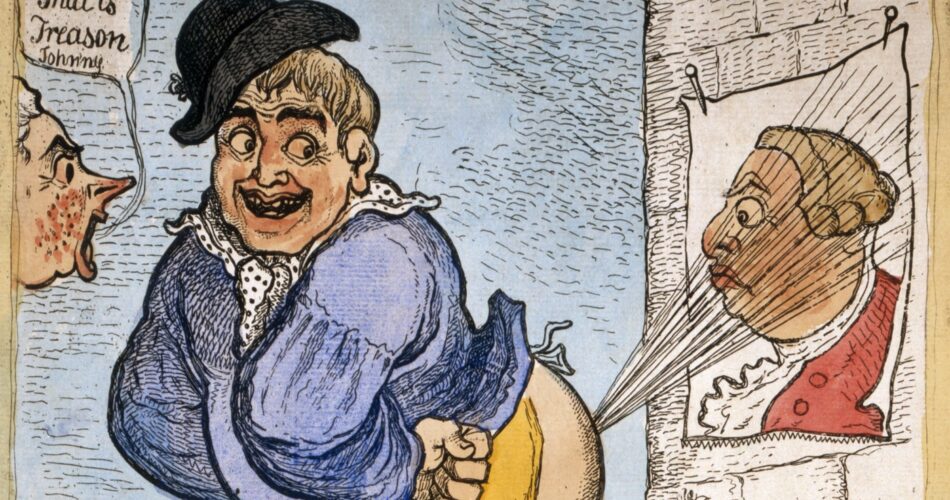Fart jokes traveled through History
Fart is art, the word itself says. Fart jokes are among the most effective types of bodily function-related humor that have been used throughout history in all cultures. The oldest joke ever documented, which dates back to the Sumerians in 1900 BC, was a fart joke: “Something which has never occurred since time immemorial; a young woman did not fart in her husband’s lap,” said British academic and poet Paul MacDonald.
As explained here, some masterpieces of Western literature have also been known to incorporate fart jokes. Chaucer’s Canterbury Tales contain one of the most well-known. In Miller’s Tale, Nicholas and Absalom compete for the same girl, and Nicholas chooses to humiliate his opponent. He then awaits Absalom’s beckoning of the girl from the window. And as soon as he does, Nicholas’ posterior ends up sticking out, “let fly a fart with a noise as great as a clap of thunder, so that Absalom was almost overcome by the force of it”.
In The Comedy of Errors, where Dromio of Ephesus says, “A man may break a word with you, sir; and words are but wind; Ay, and break it in your face, so he breaks it not behind”, even the great William Shakespeare resorted to the pun.
Less shockingly, the flatus is mentioned in Mark Twain’s irreverent parody, 1601. A member of the group passes gas during this fictitious conversation between Queen Elizabeth’s court and a few well-known writers: “In ye heat of ye talk it befel yt one did breake wind, yielding an exceding mightie and distresfull stink, whereat all did laugh full sore”.
When the queen asks who is responsible, a woman named Lady Alice claims innocence: “Nay, ‘tis not I yt have broughte forth this rich o’ermastering fog, this fragrant gloom, so pray you seeke ye further”.
Meanwhile, The Benefit of Farting Explained, a book by Gulliver’s Travels author Jonathan Swift, devoted an entire book to the topic. It was published by Swift under the pseudonym of “Don Fartinando Puff-Indorst, Professor of Bumbast in the University of Crackow”. According to the title page, the essay was “translated into English at the Request and for the Use of the Lady Damp-Fart, of Her-fart-shire” by “Obadiah Fizzle, Groom of the Stool to the Princess of Arse-Mini in Sardinia”. Additionally, the flatus is described as “Cure of cholick, cure of gripes, tuneful drone of lower pipes” in the introductory poetic ode.
After carefully describing the fart’s legal, social, and scientific aspects, Swift concludes that there are several different species of fart, including “the sonorous and full-toned or rousing fart”, “the double fart”, “the soft fizzing fart”, “the wet fart”, and “the sullen wind-bound fart”.
Theories of the laugher
Fart jokes are therefore timeless. However, why are they so funny for many people?
There have historically been three main philosophical theories on laughter.
- According to the superiority theory, laughter occurs when we experience “sudden glory”, as Thomas Hobbes described it: a momentary sense of superiority over another person, particularly one to who we typically feel inferior. This includes instances of slapstick humor like the pie-in-the-face or someone slipping over a banana peel.
- The incongruity theory, which claims that people laugh at the juxtaposition of items that don’t typically belong together, such as a talking dog or a bearded woman, was supported by Kant and Schopenhauer.
- And proponents of the relief theory, including Spencer and Freud, assert that laughing helps us release anxiety about topics or circumstances that are considered taboo or unacceptable by society. This explains why jokes that are based on sex, ethnicity, or religion are so popular.
However, according to John Morreall, a philosopher, anything that makes people laugh has a “pleasant psychological shift” at its foundation. It becomes evident why farts are considered to be amusing by all people if we apply this notion to flatulence. It’s because they can achieve this effect in all of the ways that the three theories of comedy have suggested.
And situations that fit the bill for all three types of humor tend to be particularly humorous like a fart in a serious context where the onlookers can feel superior watching who farted. There’s also an incongruity between a formal context and an informal behavior. In addition, there’s a relief from the nervous tension created by a taboo.
Anyway, while these theories are still being debated, people keep laughing at farts so far as they have always did.

